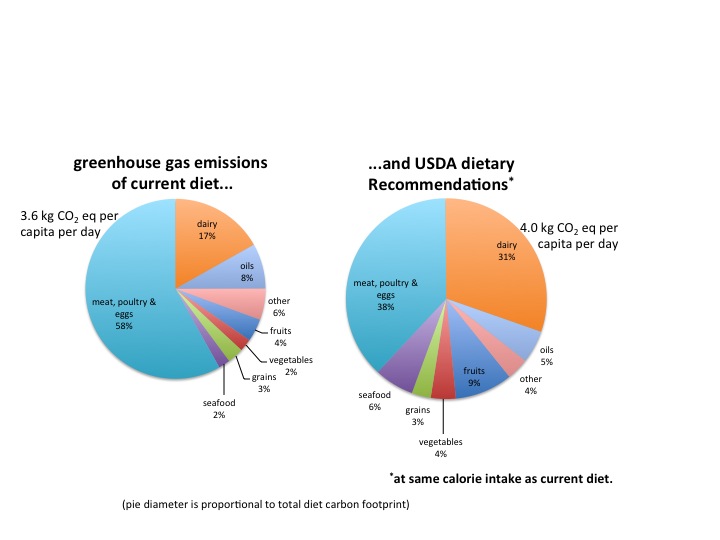Dietary Recommendations May Be Tied to Increased Greenhouse Gas Emissions

Data chart by: Martin Heller. Original charts also available as PowerPoint file.
Martin Heller and Gregory Keoleian of U-M's Center for Sustainable Systems looked at the greenhouse gas emissions associated with the production of about 100 foods, as well as the potential effects of shifting Americans to a diet recommended by the U.S. Department of Agriculture.
They found that if Americans adopted the recommendations in USDA's “Dietary Guidelines for Americans, 2010,” while keeping caloric intake constant, diet-related greenhouse gas emissions would increase 12 percent.
If Americans reduced their daily caloric intake to the recommended level of about 2,000 calories while shifting to a healthier diet, greenhouse gas emissions would decrease by only 1 percent, according to Heller and Keoleian.
A paper by Heller and Keoleian titled “Greenhouse gas emission estimates of U.S. dietary choices and food loss” is scheduled for online publication Sept. 5 in the Journal of Industrial Ecology.
“The take-home message is that health and environmental agendas are not aligned in the current dietary recommendations,” Heller said.
The paper's findings are especially relevant now because the USDA Dietary Guidelines Advisory Committee is for the first time considering food sustainability within the context of dietary recommendations, he said.
In its 2010 dietary guidelines, USDA recommends that Americans eat more fruits, vegetables, whole grains, fat-free and low-fat dairy products, and seafood. They should consume less salt, saturated fat, trans fat, cholesterol, added sugar and refined grains.
The guidelines don't explicitly state that Americans should eat less meat. However, an appendix to the report lists the recommended average daily intake amounts of various foods, including meat. The recommended amount of meat is significantly less than current consumption levels, which Heller and Keoleian estimated using the USDA's Loss Adjusted Food Availability dataset as a proxy for per capita food consumption in the United States.
While a drop in meat consumption would help cut diet-related greenhouse gas emissions, increased use of dairy products—and to a lesser extent seafood, fruits and vegetables—would have the opposite effect, increasing diet-related emissions, according to the U-M researchers.
In the United States in 2010, food production was responsible for about 8 percent of the nation's greenhouse gas emissions. In general, animal-based foods are responsible for more greenhouse gas emissions per pound than plant-based foods.
The production of both beef cattle and dairy cows is tied to especially high levels of greenhouse gas emissions.
For starters, cows don't efficiently convert plant-based feed into muscle or milk, so they must eat lots of feed. Growing that feed often involves the use of fertilizers and other substances manufactured through energy-intensive processes. And then there's the fuel used by farm equipment.
In addition, cows burp lots of methane, and their manure also releases this potent greenhouse gas.
Greenhouse gas emissions associated with producing the U.S. diet are dominated by the meats category, according to Heller and Keoleian. While beef accounts for only 4 percent by weight of the food available, it contributes 36 percent of the associated greenhouse gases, they conclude.
The U-M researchers found that a switch to diets that don't contain animal products would lead to the biggest reductions in this country's diet-related greenhouse emissions.
But Heller said he's not arguing that all Americans should go vegan, and he believes that animals need to be part of a sustainable agricultural system. However, reduced consumption would have both health and environmental benefits.
In their Journal of Industrial Ecology paper, Heller and Keoleian also looked at wasted food and how it contributes to U.S. greenhouse gas emissions. They concluded that annual emissions tied to uneaten food are equivalent to adding 33 million passenger vehicles to the nation's roads.
Center for Sustainable Systems at the U-M School of Natural Resources and Environment: http://css.snre.umich.edu
Media Contact
All latest news from the category: Ecology, The Environment and Conservation
This complex theme deals primarily with interactions between organisms and the environmental factors that impact them, but to a greater extent between individual inanimate environmental factors.
innovations-report offers informative reports and articles on topics such as climate protection, landscape conservation, ecological systems, wildlife and nature parks and ecosystem efficiency and balance.
Newest articles

Nerve cells of blind mice retain their visual function
Nerve cells in the retina were analysed at TU Wien (Vienna) using microelectrodes. They show astonishingly stable behavior – good news for retina implants. The retina is often referred to…

State-wide center for quantum science
Karlsruhe Institute of Technology joins IQST as a new partner. The mission of IQST is to further our understanding of nature and develop innovative technologies based on quantum science by…

Newly designed nanomaterial
…shows promise as antimicrobial agent. Rice scientists develop nanocrystals that kill bacteria under visible light. Newly developed halide perovskite nanocrystals (HPNCs) show potential as antimicrobial agents that are stable, effective…



